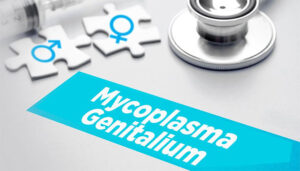Mycoplasm
Mycoplasma refers to a group of bacteria that are characterized by their unique properties. Unlike other bacteria, mycoplasmas lack a cell wall, making them flexible and capable of assuming various shapes. They are among the smallest free-living organisms and can infect humans, animals, and plants.
In humans, certain species of mycoplasma can cause infections, ranging from mild respiratory infections to more serious conditions. Here are a few notable species of mycoplasma that can affect humans:
Mycoplasma genitalium: Mycoplasma genitalium is a sexually transmitted bacterium. It can cause urethritis (inflammation of the urethra) in males and females, and it has been associated with other reproductive health issues such as cervicitis, pelvic inflammatory disease (PID), and infertility.
Mycoplasma hominis and Mycoplasma genitalium: These species of mycoplasma can colonize the genital and urinary tracts and may be associated with urogenital infections and complications, including urinary tract infections and certain reproductive health issues.
mycoplasmas lack a cell wall, making them flexible and capable of assuming various shapes. They are among the smallest free-living organisms and can infect humans, animals, and plants.
In humans, certain species of mycoplasma can cause infections, ranging from mild respiratory infections to more serious conditions. Here are a few notable species of mycoplasma that can affect humans:
Mycoplasma genitalium: Mycoplasma genitalium is a sexually transmitted bacterium. It can cause urethritis (inflammation of the urethra) in males and females, and it has been associated with other reproductive health issues such as cervicitis, pelvic inflammatory disease (PID), and infertility.
Mycoplasma hominis and Mycoplasma genitalium: These species of mycoplasma can colonize the genital and urinary tracts and may be associated with urogenital infections and complications, including urinary tract infections and certain reproductive health issues.
 mycoplasmas lack a cell wall, making them flexible and capable of assuming various shapes. They are among the smallest free-living organisms and can infect humans, animals, and plants.
In humans, certain species of mycoplasma can cause infections, ranging from mild respiratory infections to more serious conditions. Here are a few notable species of mycoplasma that can affect humans:
Mycoplasma genitalium: Mycoplasma genitalium is a sexually transmitted bacterium. It can cause urethritis (inflammation of the urethra) in males and females, and it has been associated with other reproductive health issues such as cervicitis, pelvic inflammatory disease (PID), and infertility.
Mycoplasma hominis and Mycoplasma genitalium: These species of mycoplasma can colonize the genital and urinary tracts and may be associated with urogenital infections and complications, including urinary tract infections and certain reproductive health issues.
mycoplasmas lack a cell wall, making them flexible and capable of assuming various shapes. They are among the smallest free-living organisms and can infect humans, animals, and plants.
In humans, certain species of mycoplasma can cause infections, ranging from mild respiratory infections to more serious conditions. Here are a few notable species of mycoplasma that can affect humans:
Mycoplasma genitalium: Mycoplasma genitalium is a sexually transmitted bacterium. It can cause urethritis (inflammation of the urethra) in males and females, and it has been associated with other reproductive health issues such as cervicitis, pelvic inflammatory disease (PID), and infertility.
Mycoplasma hominis and Mycoplasma genitalium: These species of mycoplasma can colonize the genital and urinary tracts and may be associated with urogenital infections and complications, including urinary tract infections and certain reproductive health issues. Causes
Mycoplasma genitalium (M. genitalium) is primarily transmitted through sexual contact, including vaginal, anal, and oral sex. The bacterium can be present in the genital and urinary tracts of infected individuals and can be passed on to sexual partners. Here are some common causes and risk factors associated with M. genitalium infection:
- Unprotected sexual activity: Engaging in sexual activity without the use of condoms or other barrier methods can increase the risk of M. genitalium transmission. The bacterium can be present in the genital secretions of infected individuals and can be transmitted during sexual contact.
- Multiple sexual partners: Having multiple sexual partners, particularly those who engage in high-risk sexual behavior or have a history of sexually transmitted infections, increases the risk of M. genitalium infection. This is because the bacterium can be present in the genital tracts of infected individuals and can spread through sexual contact.
- Previous or concurrent sexually transmitted infections (STIs): Individuals who have or had other sexually transmitted infections, such as Chlamydia trachomatis or Neisseria gonorrhoeae, may have an increased risk of M. genitalium infection. This is because individuals with STIs are more likely to engage in behaviors that can facilitate the transmission of other STIs, including M. genitalium.
- Antibiotic resistance: Antibiotic resistance can play a role in M. genitalium infections. There have been reports of increasing antibiotic resistance in M. genitalium strains, which can reduce the effectiveness of certain antibiotics in treating the infection.
Symptoms
Mycoplasma genitalium (M. genitalium) infections can be asymptomatic, meaning individuals may not experience any noticeable symptoms. However, when symptoms do occur, they can vary between males and females. It’s important to note that symptoms, if present, can be similar to other sexually transmitted infections, and the only way to confirm an M. genitalium infection is through specific laboratory testing. Here are the common symptoms associated with M. genitalium infection:
1. Males:
Urethritis: Inflammation of the urethra, the tube that carries urine from the bladder through the penis. Symptoms may include:- Pain or discomfort during urination (dysuria)
- Increased urinary frequency
- Discharge from the urethra
- Itching or irritation at the tip of the penis
- Mild to moderate pain in the genital area
2. Females:
Cervicitis: Inflammation of the cervix, the lower part of the uterus that connects to the vagina. Symptoms may include:- Vaginal discharge (may be abnormal in color, consistency, or odor)
- Bleeding between periods
- Pain or bleeding during or after sexual intercourse
- Pelvic pain or discomfort (may be mild to severe)
Preventions
Preventing Mycoplasma genitalium (M. genitalium) infection involves taking measures to reduce the risk of acquiring or spreading the bacterium through sexual contact. Here are some preventive measures:
- Practice safe sex: Consistently and correctly using condoms or other barrier methods during sexual activity can help reduce the risk of M. genitalium transmission. Condoms create a physical barrier that can prevent the exchange of bodily fluids, including those that may contain the bacterium.
- Limit sexual partners: Minimizing the number of sexual partners and maintaining monogamous relationships can lower the risk of M. genitalium infection. This reduces the likelihood of coming into contact with an infected individual.
- Get regular STI screenings: If you are sexually active, it’s important to undergo regular screenings for sexually transmitted infections, including M. genitalium. Routine testing can help detect infections early, allowing for timely treatment and reducing the risk of transmission to sexual partners.
- Communication with sexual partners: Open and honest communication about sexual health is crucial. Discussing previous STI history, undergoing testing together, and practicing safe sex can help minimize the risk of M. genitalium transmission.
- Complete treatment as prescribed: If you are diagnosed with M. genitalium infection, it’s important to complete the full course of treatment as prescribed by a healthcare professional. This reduces the risk of developing antibiotic resistance and helps ensure effective eradication of the bacterium.
- Avoid sexual activity during treatment: Refraining from sexual activity, including penetrative intercourse, during the course of treatment can prevent transmitting the infection to sexual partners or reacquiring the infection from an infected partner.

